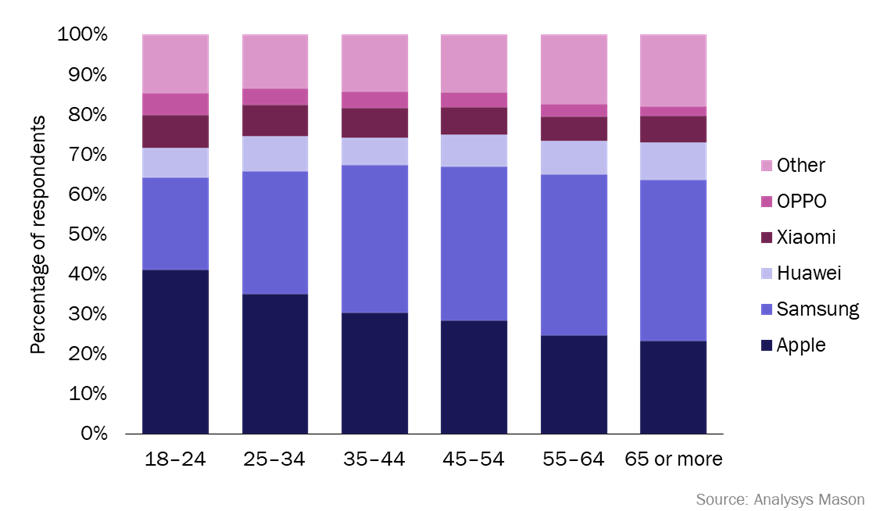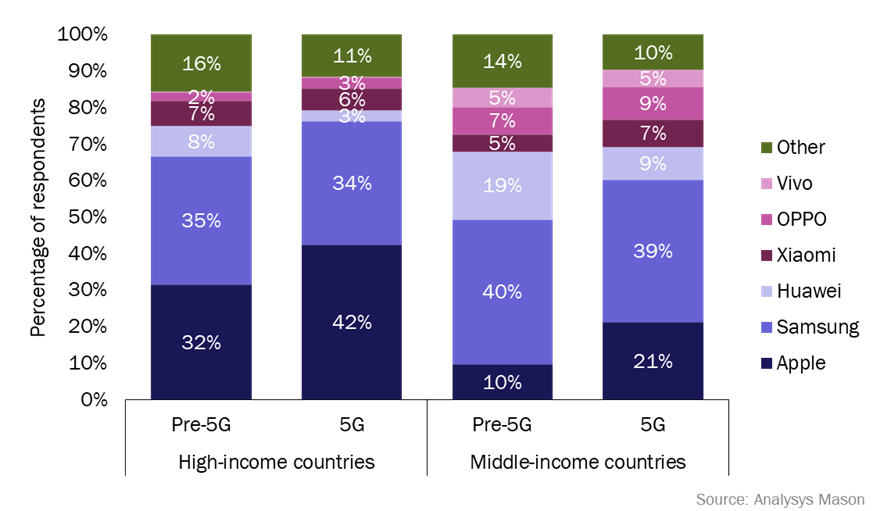Apple is benefiting from the shift to 5G more than any other handset brand
Our analysis of consumer survey data shows Samsung has been, and still is, the most popular handset brand among the countries included in the survey.1 However, the share of Apple handsets is growing while Samsung has failed to increase its share.
The increase in Apple handsets is the result of several factors; Apple is the most popular brand among consumers younger than 35; Apple has bundled services with its handsets, such as Apple TV, Apple Music, Apple Card and satellite connectivity, and older services, such as iMessage, remain important for customer retention. Apple is a more popular choice for consumers with 5G handsets compared to consumers with pre-5G handsets. According to our consumer survey, the shift to 5G is the biggest driver of Apple’s increase in market share.
This article presents a summary of the findings from Analysys Mason’s Mobile device brands: consumer survey.
Apple’s share of the market is increasing and it is the most popular brand among younger consumers
Our consumer survey data shows that the share of Apple handsets generally increases in countries with higher GDP per capita, which reflects its premium market positioning. Samsung is still the most popular brand in most regions as of 2022, but the trend in the past few years suggests that Apple will overtake Samsung as the most popular brand in most high-income countries in the next 2 years. Additionally, Apple is increasing its market share in middle-income countries where it has previously struggled to make a mark because consumers have chosen handsets from either Samsung or other, cheaper, Asian manufacturers.
The increase in the number of Apple handsets worldwide is a result of several factors.
- Apple is more popular among young consumers; for consumers under the age of 35, it is the most popular brand but its popularity decreases with increasing age (Figure 1). Conversely, Samsung increases in popularity with increasing age.
- Apple has started to add services such as Apple TV, Apple Music, Apple Card and satellite connectivity. Apple also has old services, such as iMessage, that have proved to be important to consumers. These services could help to increase customer numbers and improve retention.
Figure 1: Distribution of handset brands by age group, worldwide, 2022

Questions: “How old are you?”; “What is the brand of your most used phone?”; n = 16 790.
The migration to 5G is not disrupting current trends; if anything, it is reinforcing them
Apple is significantly more popular among consumers with 5G devices than consumers with pre-5G devices in high-income countries, as well as middle-income countries (Figure 2). In high-income countries, Apple is the most popular brand among 5G users. Its consumers are also more satisfied with network coverage and data speed than consumers of other brands. Meanwhile, Samsung is the most popular brand among 5G users in middle-income countries followed by Apple.
Figure 2: Distribution of handset brands by self-reported technology, high- and middle-income countries, 2022

Question: “What is the brand of your most used phone?; Does your current wireless/mobile plan include access to 5G?” n = 16 864.
Since 2020, Apple has increased its market share in all regions. Samsung has held its own, but failed to increase its market share while other manufacturers have lost out.
The increasing popularity of 5G has not disrupted this trend. In fact, it seems like the migration to 5G is reinforcing it and Apple is closing in on Samsung as the most popular brand.
If current trends continue, Apple will overtake Samsung as the most common smartphone brand within the next 2 years in most of the countries in our survey.
1 The countries included in our survey are France, Germany, Ireland, Italy, Norway, Spain, Sweden, UK, Poland, Turkey, Canada, USA, Australia, New Zealand, Malaysia, Philippines and South Africa.
Article (PDF)
DownloadAuthor


